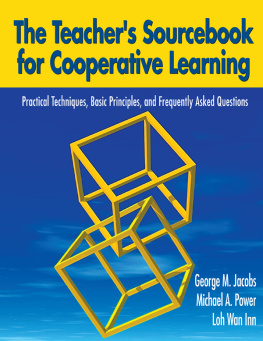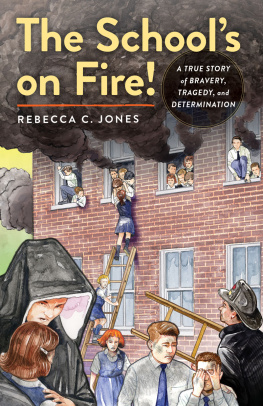Fred Jones Tools for Teaching Discipline, Instruction, Motivation
Copyright 2012 by Fredric H. Jones & Associates, Inc.
All rights reserved. No part of this publication may be stored in a retrieval system, transmitted, or reproduced in any form or by any means, electronic, mechanical, photocopying, recording or otherwise, without the prior agreement and written permission of the author.
Executive Producer: Jo Lynne T. Jones
Production and Web Design: Patrick Jones
Illustrations: Brian T. Jones
ISBN: 978-0-9650263-2-1
Library of Congress Catalog Control Number: 2007925215
printed in China
2nd Edition
00 01 02 03 04 05 12 11 10 9 8 7 6 5 4 3 2

Fredric H. Jones & Associates, Inc.
103 Quarry Lane
Santa Cruz, CA 95060
tel: (831) 425-8222 fax: (831) 426-8222
Contents
Preface
Over twenty five years ago, I published two books with McGraw-Hill entitled, Positive Classroom Discipline and Positive Classroom Instruction. I thought they should be published as textbooks. But McGraw-Hill said, There is no point in publishing a textbook for a course that no one is offering. I couldnt fault their logic on that point.
A lot has changed since then. Teachers routinely receive courses in classroom management as part of their training. During my workshops young teachers say things such as, Oh, you are the Fred Jones. You were in my college textbook. I thought you were dead.
I procrastinated in updating these first two books because, frankly, it is very hard to write books and travel at the same time. I rationalized, Theyre not dated. Fundamentals never change. Actually, that was only a half-truth. Fundamentals dont change, but my understanding of them certainly does.
I have never given a workshop without returning home knowing more than I did when I went out. New insights come from stories that teachers tell me, from discussions over lunch, or perhaps from answering a question that forces me to think on my feet in a new way. And, of course, I read constantly. I may be thinking about some aspect of body language only to read an article about interpreting facial expressions or the body language of dominance and submission. Suddenly a few more pieces of the puzzle fall into place.
I realized how much my understanding of classroom management had grown when I finally sat down to write Tools for Teaching. Discussions of key aspects of classroom management such as Meaning Business and Responsibility Training were on an entirely different level than those contained in Positive Classroom Discipline and Positive Classroom Instruction. They were more thorough and clear.
Now it is five years later, and my daughter, Anne, the college librarian, tells me, Libraries wont order any reference book with a copyright date more than five years old. You need to revise Tools for Teaching. But, its just fine the way it is, I replied. Too bad, she said. So, I began revising. For starters I added six pages to Chapter 1 and completely rewrote Chapter 2. So much for the notion that its just fine the way it is.
As before, the sections on Meaning Business and Responsibility Training have undergone significant improvement. Getting kids to stop doing what you dont want them to do and start doing what you do want them to do will always represent central issues in child management. But the most significant enhancement is the chapter on Say, See, Do Teaching which more clearly integrates interactive learning, continuous assessment, and immediate feedback during the teaching of each lesson.
This book describes the fundamental skills of being a classroom teacher. It contains all of the lessons that I have learned over the years. It is my gift back to the profession.
Acknowledgements
I credit my wife Jo Lynne with much of my interest in classrooms. Throughout my years in graduate school she was a classroom teacher, and every night when she came home from work, we had a 1-hour debriefing like the astronauts have when they return from space. During our debriefings I relived every trauma and gratification of the day, and by Thanksgiving, her students were members of the family. After years of debriefings I became very interested in classrooms. When I began my classroom management research, Jo Lynne was a collaborator, and she has been my partner ever since.
Jo Lynne was the kind of teacher who did several hours of work each evening to prepare for the next day. Knowing how hard dedicated teachers work has been a crucial consideration in the development of the classroom management methods contained in this book. It is not enough for a technique to succeed. It must also be affordable in terms of the teachers time and energy.
I must also acknowledge a large debt to my family. I come from a family of teachers and have always appreciated the competence and dedication that goes into being a teacher. In addition, my parents blending of love and firmness helped me to see discipline management in child rearing as an extension of nurturance.
Our son Patrick has been my partner in preparing this manuscript. I wanted it to have the spontaneous, conversational character of a workshop. To accomplish this, I dictated major portions of the manuscript. Patrick would type a section as I repeatedly stopped and started, and then we would read it on the computer screen. Patrick was very patient and helpful. I remember one time dictating a paragraph on verbosity. After we read it over, I said to Patrick, What do you think? He said, Dad, you dont want to know. I reread it and cracked up.
Our son, Brian did all of the cartoons and graphics for the book. He was finishing course work at San Francisco Art Institute just as Patrick and I were beginning the manuscript. Brian has cartooning in his blood. The timing was perfect. I said to Brian, How would you like your first job to be drawing 60 or 70 cartoons for my new book? We are going to do it in full color. It was not a hard sell.
I wish to thank Hans Miller, my mentor at UCLA, who gave me my foundation in behavior management. I am also indebted to a series of outstanding graduate students at the university of Rochester Robert Eimers, William Fremouw, Andrew Burka, Richard Cowen, Herbert Weis, and Kenneth Docteur as well as undergraduate Steve Carples. They were partners in the research that validated many of the procedures contained in Tools for Teaching.
I would also like to thank my daughter, Anne, for her careful proofreading. And I am especially grateful to Virginia Rossi, Dorothy Derge-Elb, Wendy Kent, and my daughter-in-law Monique Jones for keeping the office running during the months of rewriting.
The Study Group Activity Guide
Turn This Book Into A Training
The Study Group Activity Guide structures twelve 45-minute after school meetings during which teachers master the skills contained in Tools for Teaching. Each meeting includes:
reading assignments with focus questions
sharing and problem solving
performance checklists
skill building activities
The Jones family want more than anything else to have this not be just another book, but a program that is used in your classroom daily. To that end we have a FREE Study Group Activity Guide on our web site, www.fredjones.com . With the study guide, you can turn the book into a training for you personally, or for a group of colleagues.














